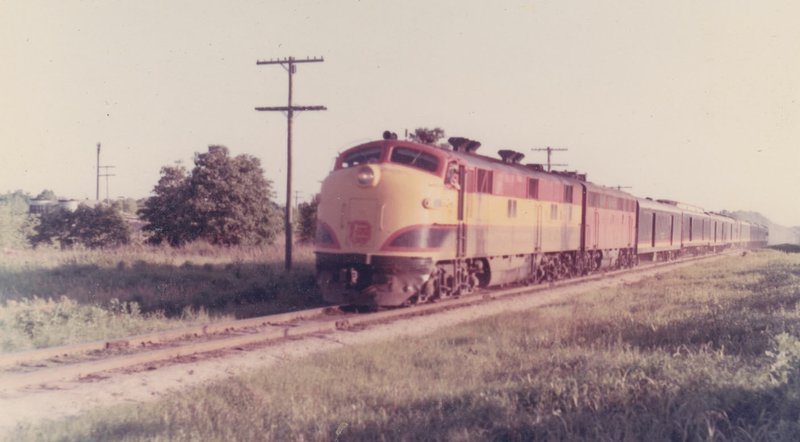DECATUR -- During the second half of the 19th and most of the 20th century, it was not uncommon to stand anywhere in the downtown areas of Decatur, Gravette or Gentry and feel the rumble and hear the whistles of a mighty steam locomotive as it chugged its way through western Benton County, pulling either freight or passenger cars for the Kansas City, Pittsburg and Gulf Railroad.
Eventually, the KCP&G became the Kansas City Southern Railroad, which skirted its way along the Kansas, Oklahoma and Texas eastern borders and the Missouri, Arkansas and Louisiana western borders in what was known as "The Port Arthur Route."
At the time, the railroad was an important part of commerce in this country, especially in rural areas like Northwest Arkansas. In the first part of the 20th century, Decatur and Gentry were huge agricultural communities growing berries of different varieties, apples and other commodities. And the railroad was the way to get these local crops to markets across the country.
But more than just produce found its way on the Kansas City Southern line. People depended on passenger trains to transport them from town to town and from state to state. With the modernization of passenger car technologies in the 1930s, coupled with rail car builders such as Pullman-Standard and the Budd Company, the time was right for a passenger service that gave its patrons the lap of luxury as they traveled the rails.
On Sept. 2, 1940, just before the outbreak of World War II, KCS inaugurated a new passenger service named the "Southern Belle." This service began in Kansas City and ended in New Orleans, a distance of 861 miles.
The KCS passenger service consisted of two trains; one train ran south while the other ran north. Each train took nearly two days to make a round trip.
The Belle served 17 cities, including Joplin, Siloam Springs, Mena and Shreveport along its Midwest to Gulf Coast route. But it made several short stops, one to 15 minutes in duration, at several small towns, including Gravette, Decatur and Gentry. With all these stops, the trip from one end of the route to the other took 16 hours and 15 minutes to complete.
As Kansas City Southern extended the Belle's route, it took 21.5 hours to complete a one-way trip
Prior to the KCS launch of the Southern Belle's inaugural run, a beauty contest was held to select the pride of the Southern Belle' representative. Thirteen major cities along the route held their own contests and eventually picked one woman to represent each of those cities. Helen Ganns represented Siloam Springs in this contest.
Now it was time for KCS to put a "face" to its new train. The railroad chose 18-year old Margaret Landry from Baton Rouge, La., for the job during the KCS contest in New Orleans on Aug. 24, 1940. She toured with the train for a few weeks. In fact, the drumhead, which is usually affixed to the door or under the window on the back of the last car, featured a portrait of Landry in her Southern belle bonnet and parasol.
When the Southern Belle pulled out of Union Station in Kansas City, it was pulling three new sets of lightweight passenger cars built by Pullman-Standard. Each set consisted of a combination RPO (railway post office)/dormitory car, a 74-seat coach car and a dining-observation car. In addition to the new sets, the Southern Belle pulled three refurbished sleeper cars, each with several roomettes and double bedrooms. Two of these sleeper cars bore the names of Sulphur Springs and Siloam Springs in honor of the two full-stop stations in northwest Arkansas.
Steam power was on its way out when the Southern Belle began service in 1940. The newer, more cost-effective diesel-electric locomotives were taking over as the passenger service engines. The Belle had a pair of E-3 diesel-electric locomotives relegated to the Southern Belle.
Although the exact number of passengers which traveled on the Belle is not known, low ridership in the late '60s, coupled with the United States Postal Service cancellation of mail service in 1968, led Kansas City Southern officials to discontinue the Southern Belle passenger service.
On Nov. 3, 1969, the southbound Belle pulled out of Kansas City's Union Station at 10:30 a.m. bound for New Orleans. At 9:30 p.m. the Southern Belle pulled out of New Orleans for the last time bound for Kansas City. And 21.5 hours later, the end of an era made its final appearance at Union Station.
But this is not the end of the Southern Belle story.
Michael Haverty, the new president of the KSC in 1995, revived the Southern Belle as the railroad's new executive train. Unfortunately for Haverty, all the original locomotives were sold off. However, all was not lost for, with a little footwork, company executives were able to find four former Canadian National locomotives, three EMD FP9As and an F9B. These locomotives were purchased by KCS and painted a very dark green, similar to the paint scheme of the business fleet. Numbered 1-4 and named Meridian, Shreveport, Pittsburgh and Vicksburg, they were placed into executive service.
The Kansas City Southern "Southern Belle" continues its runs throughout the United States and Mexico. On rare occasions, the Belle and her locomotives and 10 cars make a trip down the train's original route -- down through Joplin to Noel, Mo., and then over the border through Sulphur Springs, Gravette, Decatur and Gentry to Siloam Springs, just as it progressed 50 years ago, and to points beyond.
To the Kansas City Southern Belle and her crew, we (the ones who rode her so many years ago) extend our gratitude for its faithful and tireless service.
General News on 08/14/2019
